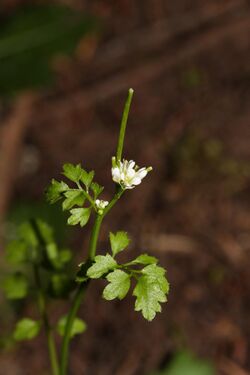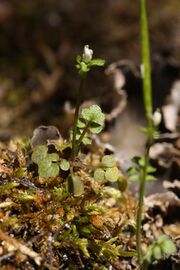Biology:Cardamine oligosperma
| Cardamine oligosperma | |
|---|---|

| |
| Scientific classification | |
| Kingdom: | Plantae |
| Clade: | Tracheophytes |
| Clade: | Angiosperms |
| Clade: | Eudicots |
| Clade: | Rosids |
| Order: | Brassicales |
| Family: | Brassicaceae |
| Genus: | Cardamine |
| Species: | C. oligosperma
|
| Binomial name | |
| Cardamine oligosperma | |
Cardamine oligosperma is a species of Cardamine known by the common name little western bittercress, native to western North America.
Description
C. oligosperma is an annual or biennial herb growing from a taproot. It produces one or more upright, branching stems 8–50 centimeters (3–18 inches).[1] The leaves are divided into many leaflets. The plant generally has a large basal rosette and smaller leaves further up the stem, each with 5–9 nearly round leaflets.[1] Most prominently blooming in early spring and early autumn,[1] the inflorescence is several centimeters long and bears many flowers with white petals just a few millimeters in length. The fruit is a silique (pod) up to 2.5 cm (1 in) long,[citation needed] containing 15–22 seeds.[1]
Taxonomy
Oligosperma is Greek for 'few seeds'. Common names include snapweed and shotweed for the plant's tendency to throw seeds when touched.[1]
Distribution and habitat
It is native to western North America from Alaska to California to Colorado, where it grows in moist mountain habitats.
Toxicity
The plant often throws its seeds when touched, which can cause irritation if they contact the eyes. Younger, more succulent plants are less likely to be carrying seeds.[1]
Uses
The leaves are edible raw and other tender parts of the plant can be cooked,[2] though have also been eaten raw.[1]
References
- ↑ 1.0 1.1 1.2 1.3 1.4 1.5 1.6 Benoliel, Doug (2011). Northwest Foraging: The Classic Guide to Edible Plants of the Pacific Northwest (Rev. and updated ed.). Seattle, WA: Skipstone. pp. 41. ISBN 978-1-59485-366-1. OCLC 668195076. https://www.worldcat.org/oclc/668195076.
- ↑ Nyerges, Christopher (2017). Foraging Washington: Finding, Identifying, and Preparing Edible Wild Foods. Guilford, CT: Falcon Guides. ISBN 978-1-4930-2534-3. OCLC 965922681. https://www.worldcat.org/oclc/965922681.
External links
| Wikimedia Commons has media related to Cardamine oligosperma. |
- Jepson Manual Treatment - Cardamine oligosperma
- USDA Plants Profile; Cardamine oligosperma
- Cardamine oligosperma - Photo gallery
Wikidata ☰ Q5038234 entry
 |



